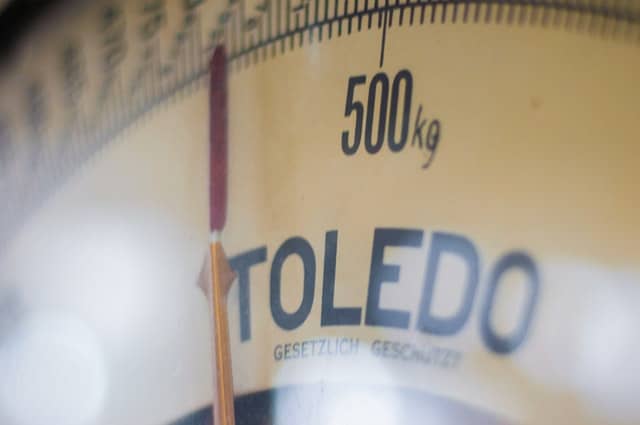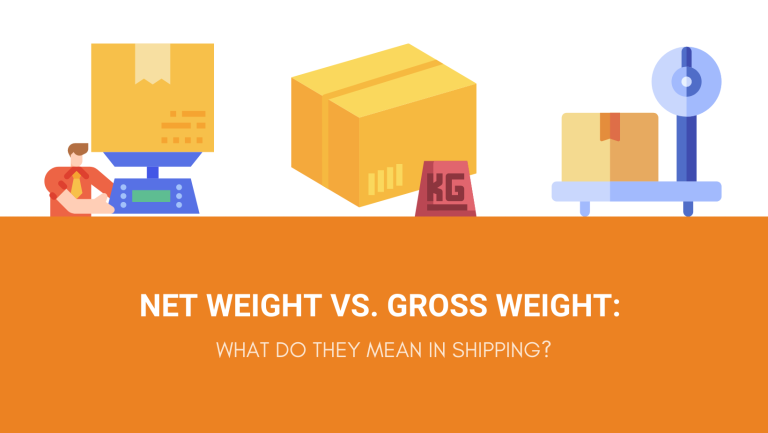Calculating the weight is one of the most important factors in determining the overall price of your shipment. Net weight and gross weight are calculated by most shipping and transportation companies.
It is up to the shipping company how they prefer to charge you. They can either charge as per the net weight or gross weight of your package. So, you need to understand every detail regarding net weight vs gross weight.
In this article, you will understand the definitions of both, the differences between them, and every other related information.
Let’s start right away.
What Is Gross Weight?
The gross weight is the total weight of a product and its packaging.

The Definition of Gross
It would be helpful for you to understand the gross weight if you understand what exactly the word “gross” means.
The word gross means “without deduction or subtraction”. This word is used as a prefix to many other words.
For example, gross profit would mean the total profit without deducting the costs and expenses, etc. Gross income would mean the total income without deducting the income taxes, etc.
So, the gross weight would refer to the total weight of the complete package without deducting or subtracting any factors that would contribute to its weight.
Example of Gross Weight
If you have ever ordered a product online, you must have received a parcel that contains your product inside a packaging.
The total weight of that parcel before opening the packaging is the gross weight. It will include the weight of the packaging material along with any kind of wrapping, taping, and protective material inside or outside the packaging.
What Is Net Weight?
The net weight is the actual weight of the product without any external material or packaging, etc.
The Definition of Net
The word “net” refers to anything left when there is nothing else to be taken away. Just like the word “gross”, the word “net” is also used with many other words.
For example, you would encounter the words like net income and net profit, etc.
The net income would refer to the portion of income after subtracting the income tax and expenses, etc. Similarly, net profit would refer to profit after deducting the business expenses.
So, the net weight of a package would mean the weight of the product after subtracting the supporting material like packaging and safety material, etc.
Examples of Net Weight
When you receive your product from an online order, you can calculate the net weight of the product by opening the parcel.
You can observe the net weight of the products in your daily lives. When you buy grocery items, you will perceive that the net weight is mentioned on most of the products.
For example, the net weight is mentioned on the bottle of jam, pack of cream, milk pack, etc.
What Is Tare Weight?
Tare weight simply refers to the weight of the packaging or other factors contributing to the gross weight of the products.

Simply put, the tare weight is the weight of everything except the weight of the actual product.
We have studied the gross weight and net weight so far. You can say that the remaining weight of the package is the tare weight.
Example of Tare Weight
For example, you receive the product that you ordered online and it has a gross weight of 2 lbs and a net weight of 1.5 lbs. The remaining 0.5 lbs would be the tare weight of that package.
Let us compare the tare weight with gross weight and net weight so that you have a clear understanding of these three important terms.
Tare Weight vs Gross Weight
If you have the tare weight and the gross weight of the product, you can get the net weight by subtracting the tare weight from the gross weight.
The formula is as follows.
Net Weight = Gross Weight – Tare Weight
Tare Weight vs Net Weight
As we already studied, the net weight is directly related to the tare weight of the parcel. If you have the tare weight and the net weight of the package, you can calculate the gross weight of the product.
The formula is as follows.
Gross Weight = Tare Weight + Net Weight
Differences between Gross Weight and Net Weight
You must have an idea of the main difference between gross and net weight by now.
You can notice the difference between the gross weight (without opening the package) and the net weight (the weight of the actual product inside the parcel) of the package that you received from your online order.
The following points will help you understand the differences between gross weight and net weight.
- The gross weight of a product will generally be higher than the net weight of the product.
- The net weight cannot be lower than the gross weight.
- Most shipping companies will charge the package according to the gross weight of the product.
- Online products are packaged keeping in view that the packaging contributes as low to the gross weight of the product as possible.
Importance of Gross Weight and Net Weight
This is very important to know how to calculate the gross weight and net weight of the packages especially if you keep sourcing products from other countries.
A slight mistake in calculating the weight of the shipments can lead to huge losses. So, you must double-check how the gross weight or the net weight of your packages are calculated by the shipping companies so that you can validate their pricing.
This is also helpful if you are shipping products yourself. You must know how to save costs on shipping the items via transportation companies.

We will discuss the tips to save shipping costs later in this article in detail.
FAQs about Net Weight and Gross Weight
We have answered the frequently asked questions regarding these two types of weight calculations. Read the answers for more clarity regarding weight calculation in the shipping industry.
How Are the Net Weight and Gross Weight Calculated?
There are two most popular ways of calculating the weight of the package in the shipping field. They are mentioned below.
- Actual Weight
- Volumetric Weight
Let us analyze both in detail.
Actual Weight
The actual weight of the package is simply calculated by putting the package onto the weight machine. The weight is then noted down in the accepted measure of weight in kilograms (kg) or pounds (lbs).
Volumetric Weight
The volumetric weight refers to the weight of the package in terms of its volume. It is calculated by measuring the volume of the box in cm3 and dividing the volume by a volumetric divisor (5000 or 6000 depending upon the shipping company’s policy)
The formula for calculating the volumetric weight is as follows.
Volumetric Weight = Volume in cm3 / Volumetric Divisor
For example, if a package has a volume of 10,000 cm3, and the volumetric divisor is 5000, the volumetric weight will be 2 kg.
The shipping companies prefer to measure the volumetric weight in case the package is large in volume but low on measuring weight on a weight machine.
They calculate the volumetric weight to decide whether they should charge according to the volumetric weight or actual weight.
They usually charge as per the weight that has a higher value.
How Is the Gross Weight Calculated in Different Transportation Methods?
The gross weight, as we learned earlier in this article, is everything else that contributes to the weight of the package other than the actual weight of the product.
But this additional weight is not limited to the packaging in every case.
Shipping companies calculate the gross weight of the package in different ways depending upon the mode of transportation used.
Let’s analyze how the gross weight is calculated for different types of transportation methods.

Gross Weight for Transportation By Sea
For the containers or packages that are meant to be traveled by sea, the gross weight would simply refer to the net weight and the tare weight of the package.
This calculation is fair and generous for the shippers. That is why packages by sea are always considered most economical.
Gross Weight for Transportation by Road
The gross weight of the packages that are meant to be transported by road would be calculated as the net weight of the product combined with the tare weight along with the weight of the transporting vehicle.
Yes, the weight of the vehicle is added up to the weight of the package to calculate its gross weight.
That is why the costs for transportation by road are comparatively as compared to the costs of transport by sea.
Gross Weight for Transportation by Air
The gross weight of the products transported by air is calculated by adding up the net weight of the product along with the tare weight and the weight of the crew and passengers on board and the weight of the airplane and its fuel.
Yes. That is exactly why transportation by air is always the most expensive option for dispatching your products.
Net Weight vs Gross Weight: What Do Shipping Companies Charge For?
The shipping companies work on the basic principle of making profits. They usually charge you for the higher weight option for obvious reasons.
That is why they have devised the method of volumetric weight. So, they would most probably charge for the gross weight of the package.
You would certainly have a point for not being charged for what you will not use: The packaging. But the packaging and other protective material to support your product are also important.
You might only be interested in the product inside the packaging but the overall size or weight of the complete package is what matters for the shipping companies.

That is because they would have to allot space as per the size and the weight of the packaged product.
How Can You Save Costs in Getting Charged for Weight in Shipping?
If you are dispatching the products yourselves, you should make sure to use the packaging material as low volume and weight as possible.
You cannot do anything to reduce the weight of the product inside the packaging. But the wrapping and packaging are in your own hands.
For example, you can avoid using hard paper packaging if it weighs higher. In that case, you can go for plastic packaging instead.
In another case, you can avoid using extra protective material like bubble wrapping of the product if the product does not require it.
You can also be cautious of using the extra taping around the packaging.
You can avoid entering into the higher-weight slabs of the shipping companies by utilizing these little techniques.
NicheSources helps its clients save costs on the worldwide shipping process by optimizing the smartest possible ways. Some of them are briefly discussed below.
- We choose the shipping origin smartly so that the shipping distance has a minimal impact on the costs. We also take leverage of our warehouse in the USA to deliver products smartly.
- We have more than 15 shipping carriers onboard so that we may choose a courier that is fast and more cost-friendly.
- We cover over 200 regions all over the world and have our shipping collaboration in almost every shipping destination.
- We use optimal packaging so that you are not overcharged for the extra dimensions.
- We help our clients make use of bulk discounts on shipping in high volumes.
- Depending upon the nature of the products, we use as much lightweight packaging as possible to save on the net weight of the parcels.
How Can You Avoid Calculating Net Weights and Gross Weights for Your Shipments?
If you don’t want to be involved in careful calculations of the net weight and gross weight of the shipments, you can opt for signing the suitable shipping Incoterms.
You can choose to select the incoterms that will make you free from shipping responsibilities. For example, in DDP Incoterms, you can put all of the shipping responsibilities on the seller of the product.
In that case, you won’t have to worry about packing the products to save on shipping costs and other shipping fatigues.
Summary
Gross weight and the net weight of the products are the things that we deal with in our daily lives. Knowing about them always helps you determine what costs you may have to pay for your shipments.
We hope that this article must have cleared your concepts regarding the net weight vs gross weight, especially from the shipping point of view.
If you want any help regarding sourcing products from China, we are just a click away. We will also help you with the shipping weight calculations. Ask for a free quote today and start buying from China to establish your business.

